Introduction
The report is going to focus on a strategic review of Benenden hospital, which is one of the most popular medical centers in UK. Before going through the organizational context in relation with core issue of sourcing, at first it is essential to have an initial overview of the selected service agency along with sourcing feature in relation with that perspective. The selected hospital is an independent entity that had established for the objective and purpose of offering qualified level of diagnostic, medical, and surgical services for all. From the time establishment, the home affiliates of Benenden Healthcare Society were being in ownership of the hospital, which is committed to give cordial health care to both private and NHS (National Healthcare System) patients. Today, Benenden is committed of delivering a large number of serviced like- cardiology, continence care, X- Ray and Ultra Sound, gastroenterology, basic surgery and medicine, gynecology, respiratory medicine, urology and so one. Aiming of running this social agency with a mission of maintaining the motto of healthcare provision of delivering the members high class healthcare in a concern of their affordability and ensuring the corporate- level mannerism and thoughts and thus creating a long- run forecasted relationship with the prospects, service oriented sourcing takes a major concern for the hospital. Since the healthcare industry is going through the phases of intense pressure, now the sourcing issues of this sector generally incorporates some specific issues of finance, regulation, structure, operations, technology and mostly the supply chain which all take a rigorous impact in making managerial decisions. So, clearly stating, by developing a sourcing strategy, Benenden will need to undergo a cyclic process for the purpose of linking its operational functionality with intended multiple networks for sourcing options as a basic server of managing forward and backward performance of the company (Annual report 2007 of Benenden hospital).
Situational analysis
Before going inside of the required situation of Benenden hospital, it need to analyze current situation of the company which consists of various factors regarding general operational philosophy and values, financial valuation, recent service plan, performance judgment, customer review process, service variation along with quality measurement, continuous improvement effort and committee management etc. Those issues have described as following:
Mutual principles
The hospital has developed upon some basic values regarding public health and welfare, solidarity, non- profit motive, independence etc. The first aspect explains the society activities for promotional and mutual maintenance of health to all the participants as well as their contenders within the decided structure of the entity. In terms of solidarity, the hospital is not limited in serving medical services without any membership. It also maintains a principle of equilibrium flat- rate payment system with an additional support of leveraging the registered members and nominees based on equity non- exclusivity without any concern of several variables like- age, race, income, sex, occupation, religion or some other cultural issues. Democracy has maintained in distribution of share and formal taking part of the associates to prove a higher degree of accountability and transparency. Finally, the hospital is a non- profit entity which is running its overall activities within a monopolistically competitive market. So, for a successful existence, such organizations needs to cost effective in generating better value to the customers as patients where Benenden keeps up a strategy of reinvesting the monetary extras for providing further advantages of their members (Annual report 2007 of Benenden hospital).
Present management committee
The core responsibility of management team is to monitor and control risk factors. For such objective, the committee has undertaken a number of safety policies on the conditional basis of the auditors’ effort of delivering non- audit services. For ensuring internal control and risk management issue, each single level is evaluated with a comprehensive report to top management and after to the committee by CEO. Furthermore, this context has regularly assessed with top importance. After receiving the report from home, auditors, a tailored prevention program are designed, which is then presented to the management committee while outsourcing is also occurred in case of auditing for a receipt of such report. Remuneration committee has formulated upon the focus of benchmarking practice of executive bodies for the vision of offering an acceptable compensational package. The governance and democracy oriented committee is responsible for conducting essential inquiries and suggestive issues for some identified segments of the business as corporate governance, legislation, democracy, branches, celebrations and conferences and membership linkages. Similarly, the strategic division is liable for the performance of such issues in maintaining organizational business strategy, transactional omission and reviewing, monetary investment, society development and performance analysis in terms of projected business plan (Annual report 2007). So, a sample of the hospital’s management committee report for the year 2007 can be presented as below:
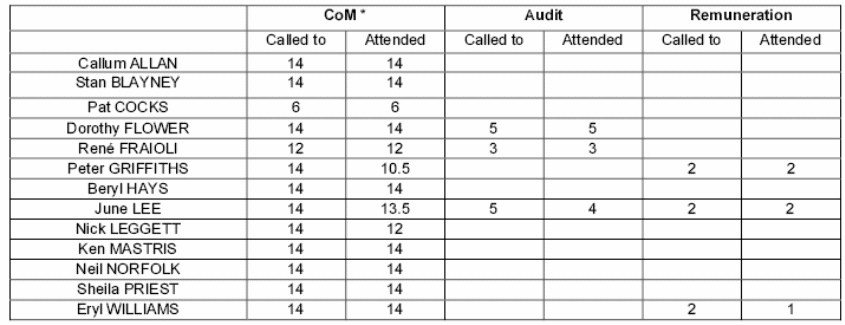
Variety and quality of medical care
As mentioned previously, Benenden hospital delivers a wide variety of medical items ranging from general medicine to specialized surgery. Such services have offered by posing some special characteristics. Normal administration has allowed by formal membership while private patients has also allowed for getting the same treatment in terms of their personal medical insurance funding. Additionally, the hospital tries to maintain clear and timely servicing agreements with comprehensive communication for generating perfect, applicable, and adoptive information. Confidential services have delivered for studying the patients and their cases sincerely and thus making physiological, mental, motivational, and cultural care. So, the entire quality assurance program is maintained through health and safety, customer records and informed substance, visiting, patient journey and feedback, traveling outlines, surgery at day, in and outpatients, religious and social serving, relationship and responsibility aspects and related research issues (Annual report 2007).
Continuous improvement program
Since the quality assurance program takes a major part of the entire performance of the hospital, it shows a higher level of consciousness for a proper management of continuous improvement effort. Actually, it is the sector, which tends to cover most of other aspects of situational rationalisms. In case of sourcing, this hospital follows a mixed strategy containing both internal and external visions which can be described as:
- Internal operational policy: The hospital owns and maintains a self- managed annual operational policy, which has designed to devote its internal personnel and experts for the need fulfilment purpose of the patients. This program incorporates a frequent review and modification of customer amenities as well as application of modern health care supports. Taking a core though in mind to become successful like any other entities, Benenden is curious in evaluating the past year’s progression, which is helpful in deciding organizational objectives of existing year through an internal judgmental analysis of market position (Benenden hospital 2009).
- Internal governance: Here, the internal governance has established to formulate and assist per year business plan, which is in major concern of the hospital’s management committee. Therefore, the Director is in prime position for daily management programming in terms of Clinical Services and Medical Director associated with Governance Manager. All of those top-level executives form the internal management committee who keep the liability of placement and safeguard of the clients, employees and other related personnel. It is also responsible for setting monitoring scheduling and considerable initiatives for upgrading the general hospitalization processes. Those programs involve conducting customer satisfaction surveys on a continuous basis with a support of an external expertise in order to gather patients’ perception of the delivered serviced or simply called feedback and yearly multi- disciplinary auditing. Such program has undertaken to develop the quality and result of customer care in terms of each feedback (Benenden hospital 2009).
- Control of infection strategies: Recently, the hospital is trying to develop a procedure, which would be effective in establishing an open culture, which would tackle any incident resulting from disability of implementation of prioritized plan. In association with centralization, logging, or monitoring, Benenden runs this task by utilising incident and close elapse reporting for altering and recovering practice (Benenden hospital 2009).
- Managing risk: Through a risk strategy, a social non- profit agency as a hospital ensures a safeguard and environmental security for all admitted patients and all class staffs. Motivating with this issue, the internal society of Benenden desires to minimize overall risk and related vulnerability with accessible asset management. For this, it has selected to go forward with a proactive technique for assessing those problematic issues for which it is dependent upon the inner governance committees that also get supports from preserved incidental and complaint management modules. Such items incorporate clinical and non- clinical vulnerability, safety, and health issues human controlled, work and fire related provisions (Benenden hospital 2009).
- Handling objections: According to Benenden hospital’s philosophy, objections are significant learning module as they can expose true and important experience of their clients. From this motivation, it considers patient’s complaints and criticisms sincerely and tries to have some lesson from that source. Additionally, it takes necessary steps of required modifications while a final report is to submit to the governing bodies four times a year, which will have to contain equivalent statistical figures and discussion (Annual report 2007 of Benenden).
- Clinical pointers: The selected clinical indicators have gathered once a month. This task has operated by the governance committee, which is generally involved in corporate periodical reports presented to the joint authority for implementation purpose. Some facts are highly influential here as uncertain re- admission, usage of blood, uncertain admission to HDU, shifting to other medical centers, stated negative medical incidents, range of residing in the hospital (over 14 days or more), written medical objections and deaths etc. (Benenden hospital 2009).
- Tasks of hospitality unit: This department is especially responsible for housekeeping as well as catering. Since the hospital Trust is an affiliate of BICS or British Institute of Cleaning Sciences, it generally performs the role of qualified instruction centre, which assigns three associates who are qualified training assistants, and all other housekeeping employees have educated by standards of BICS. On the other hand, the existing cleaning customs have evaluated by an auditing process, which has connected sprightly for risk measurement procedure of each criterion. The catering department of Benenden has recognised especially for its outstanding performance since it has gained the Gold Hygiene Award along with Heartbeat Award for internal specification. In this process, patients have the opportunity to make a direct communication with catering employees while preferring from an especial cater list. Then the engaged staff will confirm that any particular dietetic order is met (Benendenhospital.org.UK).
- Responsibility of Care Quality Commission: This commission indexes Benenden while its qualified inspectors yearly inspect the hospital. They conduct such verification based on National Minimum Standards that the hospital society is verbally and legally committed to imply. Although the inspection would announce or not, Benenden generally wishes to has the former one, which has published each year by the commission’s web site for public feasibility. Beside this, the internal committee maintains a regular channeling with this external body. As a national obligation of maintaining substantial standard is applicable only for individual healthcare industry, the hospital motto of running with “Standards for Better Health” would match with that perspective. Furthermore, it tries to follow a better timing schedule to achieve that goal (Benenden hospital 2009).
Additionally, the commission is responsible for managing the overall cleanliness of the hospital since it is a part and parcel of keeping a favorable hospitalization in target patient’s mind. For such purpose, it controls a 10 members cleansing unit. 5 members security team is also maintained by the committee.
Existing service plan
The present service plan is composed of consideration with engagement with staff, application of policies, employment, and organizational responsibilities. Numbers of staffs are involved to carry out safety, health, and welfare activities. Notably, the society incorporates almost all of its staffs through in- sourcing with a primary training to maintain some related rules and regulations (Rawlinson & Howie 2007). Operational policy has maintained from line execution to operational level with necessary review in terms of supervision. The Hospital Director, Departmental Heads or Warden, Governance Head and Directors have posed with the corporate liability segment. Besides, the general employees are required to supply of information regarding hazards to the line section, searching remedy for initial injury, assists in emergency operations or the like, utilisation of safe instruments to prevent risks, make alarms at external hazards and fully committed with assigned responsibilities (Annual report 2007 of Benenden hospital).
Evaluation of potential opportunities
Although the previous section has identified some of the integrated sectors, which are contributing greatly for generating different types of values for Benenden hospital, it also poses some value gaps, which could minimize the existing strategic module. It can reform with some relevant potential endeavors, which would able to furnish a more favorable image to gain more monetary value of the hospital. According to our strategic analysis, most of such efforts would relate with marketing and supply chain planning of the society in terms of target positioning, marketing research and test marketing, risk management, integrative opportunities or comprehensive valuation of money (Annual report 2007). All of those relevant aspects have clarified below:
Potential target positioning
Through a differential positioning, Benenden would be able to achieve a distinct image in the target audience’s mind on important attributes. That mean, by using this strategy, it would implant the brand’s unique benefits and differentiation in patient’s mind (Kotler & Armstrong 2006). For this, Benenden would modify its present marketing and positioning by preparing a perceived brand-positioning map (Kotler & Armstrong 2006). Next, identification of possible competitive advantage is required in terms of creating service, channel, and people differentiation emphasizing on careful treatment orientation, communicable medical dealings, and outsourced medicine experts. All of those efforts would take a grater contribution in maximizing financial valuation of the entity (Kotler & Armstrong 2006). In deciding the selected promotional attributes, Benenden would like to emphasize on importance, superior, communicable, affordable, and profitable criteria (Kotler and Armstrong 2006). And finally, the overall positioning strategy should be targeted in terms of “more for the same” value proposition by promising its regular and irregular members for giving the chance of getting better medical care at same price that other hospitals generally charge. So, all of those integrated stages in target positioning would be effective to reach the hospital in place through which it would be able to maximize its marketing orientation and goal (Kotler & Armstrong 2006).
Marketing research and test marketing
As we have come to know that, Benenden undertakes limited range of marketing research and test marketing activities in terms of asking patients to know their perception. However, this stage should diversify enough since it plays a major role for setting a standard and realistic goal for management decision-making (Malhotra 2007). But before so, a comprehensive assessment for formulating decision for each project (per treatment system) is needed, as:
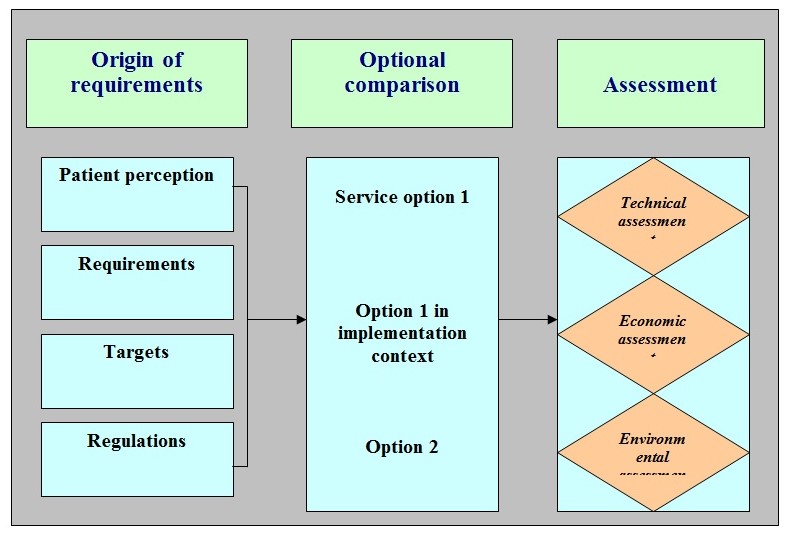
Since the situational analysis shows that it is not possible for the hospital to conduct a formal marketing research and to understand patient’s feedback properly upon each of the individual service, the hospital should take the help of an external professional marketing research firm to meet such organizational objective (Malhotra 2007). Therefore, the entire projected process can summarised as:
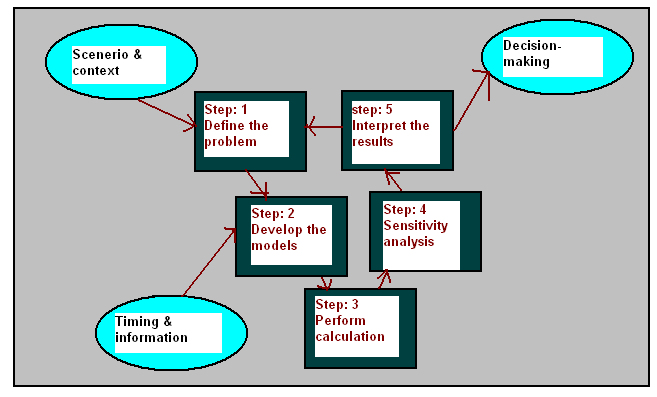
Therefore, by understanding the present scenario and situational context, the first step of problem definition should be undertaken. Development of necessary graphical, mathematical, or verbal model would be dependent upon project accomplishment timing and informational availability. Next, the delivered performance would calculate to conduct a sensitivity analysis while the outcome interpretation would assist in decision- making within the projected time (Chen & Khumpaisal 2009). By this way, the performance of each new and present treatment module, process and other health and safety issue would measure. Thus, the processed information will be reliable and realistic enough to make necessary modifications in the yearly business plan. One major thing should take in mind that the informational statistics should not only base on the primary data gathered by interviewing the two groups of patients but also focusing a group interview is essential. As a theme of exploratory research for the vision of gaining, a primary knowledge of the issue where participation of in- sourced and outsourced consultants would add extra feasibility of the study.
Market testing is generally applicable for the introduction of any new service promoted by the hospital. Market testing formally indicates the phase of new- service development in which the service will tested in more realistic customer focused market settings. Such program would be exclusively effective for the hospital because it would let any newly imported medical service like- a new form of cancer treatment along with its entire promotional programs casing positioning strategy, advertising, service charging, budgeting level and public acceptance to be pre- tested within a competitive industry context (Kotler and Armstrong 2006). Although market testing for each offer would not be highly cost effective, Benenden should make a better consideration of conducting such testing based upon the weight or necessity of projected dealing. Among a number of alternatives involving standardized, controlled and stimulated approaches, it should decide to go further with controlled test marketing by selecting a panel of patients who in need of consuming such item. It also incorporates tracking individual customer behaviour for the offered service from first dose to the completion one. Implementation of this technique would be cost effective than other ones while it is also expected to generate a true feedback within a relatively shorter span of time (Turner 2008).
Risk controlling programs
The traditional risk control mechanism would not be effective in all situations. Therefore, adoption of a modern concept in managing risk would alert the hospital about different types of sector- wise risks posing a chance to come at various life cycle of business. Therefore, the risk control program applies the risk management program, which needs to be communicating in better ways to all relevant participants ranging from top to bottom level. Here, essential training program is required for not only an accomplishment of a risk management program but also to develop an extended risk management culture as well as attitude (Burke 2004).
According to PMBOK, project risk management means the systematic process of identifying, analyzing, and responding to the project vulnerability. Therefore, the risk management of Benenden hospital would follow the model below-
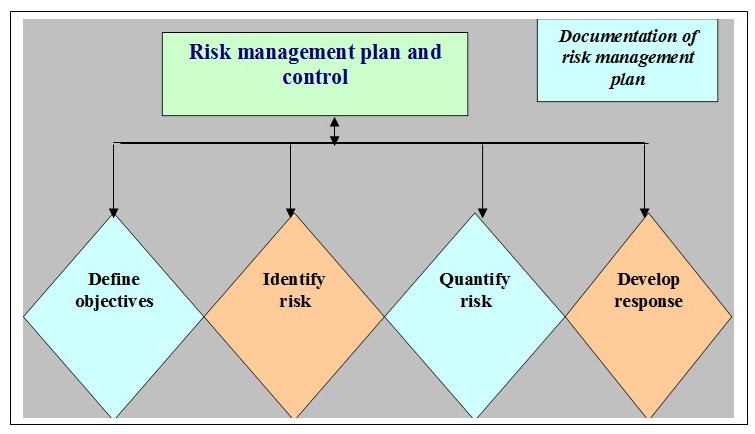
All those stages have described as following:
- Identification of objectives: – At first, a contextual plan should be developed by the specification of services and advantages which are needed to become successful. This approach would help the management committee in deciding how to deal with risks in taking the forthcoming decisions.
- Risk identification: – In would involve identification of risky areas, uncertainty, and barriers, which are responsible for limiting the task accomplishment.
- Quantification: – It assumes risk evaluation through prioritizing the levels as well as quantifying their frequency rate.
- Response development: – Explaining how to respond to the targeted risks whether by elimination, alleviation, deflect or accept.
- Risk control: – This function mainly applies the original risk management plan in terms of training of the employees of Benenden and linking with other stakeholders. Since the vulnerability and environmental context are gradually altering, this functionality would be more successful through an ongoing monitoring, reviewing and responsiveness program.
Among these, each project would have face a number of associated risks which can be shown as a unit as below:
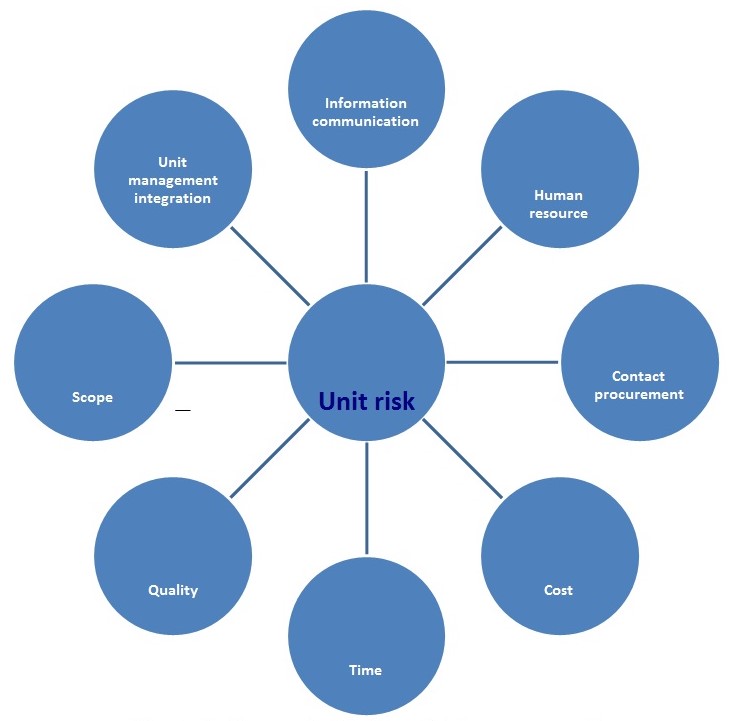
Moreover, the entire plan should be observer and updated continuously for ensuring the members for learning a lesson from recurring risks in order to make some alteration, such as:
- Altering in work opportunities
- Altering in process building method
- Altering in associated workforces
- Altering in overall supplies regarding HR, equipments and other resources
Here, the development of perceived risk control cycle would expected to be effective, which can be visualized as:
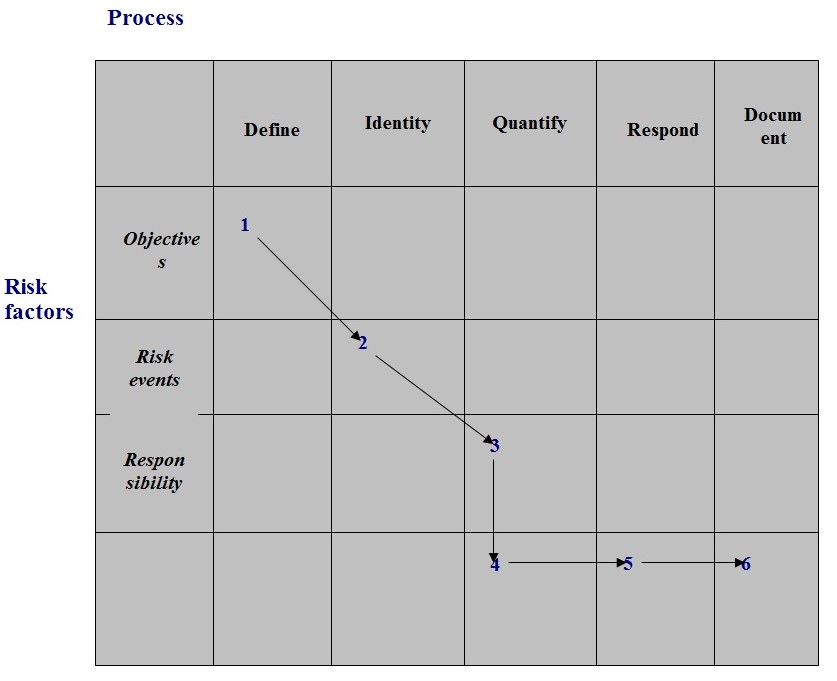
Eventually, the risk management process will turn to a completion point if Benenden could make a proper contingency plan, which is formally termed as disaster recovery plan. For this issue, a special management team needs to be formed who will perform the responsibility of development of disaster recovery plan, maintaining a control over it and making a proper implementation of that plan with adequate effectiveness and time management. It should especially taken in mind that a proper factual application is dependent on a necessary involvement of different parties of the hospital regarding employees, clients, suppliers and media (Burke 2004).
Communication program
For any forms of organization to be successful, communication is an integral pert to consider. Communication does not mean only to have a connection with external parties as outsourcing personnel, equipments or some other objects and targeted patients but also to develop and maintain an internal communication. It would aid the employees to exchange job related information and co- operation to increase the overall productivity and customer satisfaction (Burke 2004). Since Benenden hospital does not pose any clarified communication program for value addition purpose, a reluctance of developing such integrative vehicle would be resulting in generating less monetary and functional value for it. Therefore, the hospital needs to develop a specific and effective communication strategy in a view of ensuring timely and suitable generation, collection, dissemination, storage, and definitive disposition of hospital information. Additionally, it would serve the critical associations among people, conception, and information that are essential to become successful (Burke 2004). Consequently, for maintaining external communication, Benenden should ensure some communication tools as e- mail, web sites, service time progress, video conferences, mobile e- mail, and reports of the internet connections, domestic and global mobile communication etc. Similarly, the internal communication could develop through a demonstration of intranet and telecommunication facilities (Chen 2008). All of those integrated aspects can be clarifies as below:
- The present web site of Benenden hospital needs to be modifying for the objective of utilising itself as a major communication vehicle. Precisely speaking, the hospital should empower an e- business orientation within its business structure. Rather than using internet simple as a source of gathering information about the facilities and services of Benenden, a technological expertise committee should be established who would reformat the site as including commercial and non- commercial options like- hospital information, lists and qualifications and outsourced doctors, number of delivered services, marketing research and opportunity for conducting online surveys. FAQ or Frequently Asked Question opportunity, health tips regarding any current epidemic like- cancer or swine flue, log in box for online registration along with a registration form, job section especially focusing on terms and conditions for sourcing the external medical experts along with priorities in required fields, qualifications, compensation and benefits and timing. Such technological structure would be supportive enough to accomplish a better sourcing strategy and fund generation by the hospital management board (Chen 2008). Similarly, introduction of an extranet system would be effective for meeting external communication needs.
- Internal communication would establish through inter- hospital intranet, intercom, or some other telephony. These would be valuable in building strong employer- employee relationship by increasing the staffs’ communicative efficiency (Burke 2004).
- Additionally, Benenden would have to set up a function- wise communication plan, information and control system, reporting, documentation, general and progress meeting as a part of sophisticated communicative aspect (Burke 2004).
Research and development
The hospital should provide additional effort to accomplish R and D program. Under this curriculum, it should carry on in-group work with local universities and clinical research labs. Such program would enclose an opportunity of working closely with standard level of NHS Trusts while the task would cover various fields, like- general hospitalization, training of administration staffs and clinical nurses, medicine, surgery or some other techniques of treatment, multi- center medical trials or examining modern treatments as well as the evolution and appraisal of modern therapies (BRNHRD 2009). This section would help the company for accumulating external grants both from government and non- government sources. At the same time, it would furnish the paves to outsource many affluent medical surgeons and medical experts who pose adequate interest in both formal treatment and research (Annual report 2007 of Benenden).
Those are the aspects of which the hospital needs to be more conscious as performing the referred level of modifications, the overall financial and managerial condition could be developed enough for which Benenden would place a satisfactory position in terms of monetary, non- monetary and proper health care.
Identification of potential problems
The upper situational analysis is focusing upon the issue of critical difficulty in inward sourcing. Such problems are mainly notified at human resources and equipments. Specialized doctors are not available as well as necessary equipments are scarce for immediate operations. There are also scarcities in adequate cleaning and security staffs.
Identification of potential sourcing strategy
The preparation of organizational sourcing strategy requires the answering of some predetermined questions which are fundamental in nature and help to clarify the forthcoming situation of business in terms of its core characteristics, such as:
- Where is it now?
- How effective and competent its present capabilities?
- Where and what are the increasing scopes?
- How can it reach there and what roadmap would it need to follow?
Therefore, development and application of a suitable sourcing strategy of Benenden hospital will be complex enough in terms of dealing with leadership, competitive pressure, stakeholder interests, and expected results (Burke 2004). Therefore, it would assist the decision- makers in following terms:
- Keep a balance between internal and external activities, resources, and knowledge.
- Aligning organizational strategies, process flow, and technological tools,
- Keep a balance between the optimized outcomes and optimized opportunities.
While sourcing has assumed to be an effective technique to create additional values for the selected hospital, similar to other commercial and non- commercial entities, it should keep promises to follow the golden rules in sustaining over its selected sourcing strategy (Strategic sourcing for white paper). That are:
- Escape the concept from a piecemeal context, which suggests sourcing keeping apart from the formal business tactics.
- Strategic view implies delivering the desired service level in an aligned, fast, and ambitious way.
- Adoption of a holistic, organizational approach will help to achieve economies of scale by eliminating duplicity at a standard level.
- Adoption of a risk spreading and value adding sourcing method,
- Keeping the adopted strategy on an ongoing basis for getting leverage from alternative and competitive situation,
- Ensuring the managerial vision to be co- operative and helpful towards the sourcing partners, it will be advantageous from both organization- employee perspectives.
- Managerial sponsorship, central authority, and core hospital oriented supports are essential to become purposeful and successful.
- Recognition of development needed to transfer to the new framework will emphasize on a sound communication with future for turning competitive advantage for the hospital.
- Establishment of governance and service management for the formulation of sound sourcing modeling, evaluation, and implementation,
- Viable estimation of the projected operational costs against the future success rationality with the selected strategic sourcing
Therefore, the possible sourcing strategy of Benenden hospital can shape within some strategic parts, which would cover its natural rationality, partnership relationship, examination of proposed outsourcing functionality and related evaluation in terms of selected medical offerings. Such as:
Understanding the need of changes
Firstly, it is essential to identify the various sections of Benenden, which are in need of strategic changes. Managing facilities is the prominent factor in this regard while hospital premises, support services and IT are the three largest sectors, which incur most of the operational costs. So, a modified version of facilities management program could shown as-
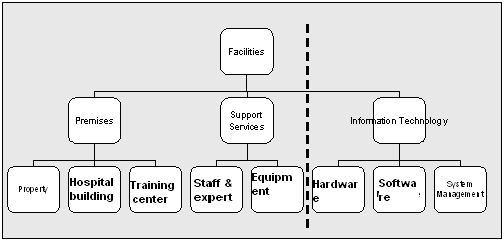
For that reason, it implies the essence of formulating a separate facilities management team which will held the responsibility of strategy and policy, management of services and intelligence that can be shown as-
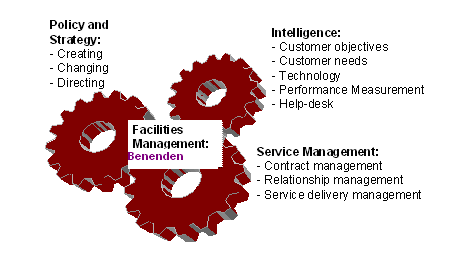
Therefore, according to Unison (2005) report, Benenden should maintain some cautions, as:
- The entire operational costs should maintain with quality along with professional expenditure, payment and other circumstances.
- The decision- makers for accumulating cleaning assets should notify infective costs.
- Maintaining environmental cleanliness both inside and outside of the hospital is equally essential as any sort of virus control preparation.
- Organizational resources have needed to be investing for more demanding criteria involving training, development, and maintenance of different wards, continuous health care, and so one.
After that, the concept of organizational development would applied at Benenden case since this is the process, which would create additional effectiveness at both organizational as well as individual project level (Robbins 1986). Some basic implementation rules are:
- Each individual personnel regarding doctor, patients and staffs ought to have dignified identity.
- Ensure environmental trust, support, and flexibility.
- Establish hierarchy based direction and control procedures.
- Organizational conflicts and misunderstanding should be resolved.
Outsourcing as a measure of strategic effectiveness
Benenden has suggested to adopting an outsourcing strategy, which is generally a subcontracting service, which allows the hospital a special opportunity to hire specific medical specialist, nurse or some other specific equipment needed for a certain purpose as an emergency operation. In short, the projected outsourcing strategy of Benenden hospital would be accomplished through the below phases:
- Service procurement: Since the hospitalization and medical service is highly competitive today, the service industry outsourcing in terms of “public- private partnership” might reveal a number of points, like the following diagram:
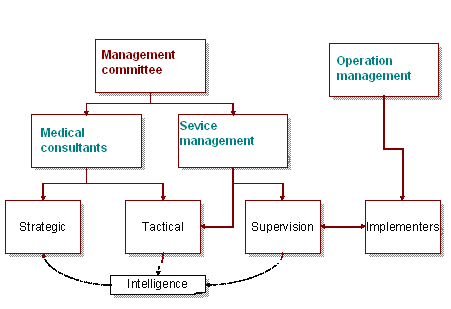
The diagram shows that strategic- operational tasks will start from managing director committee who will make two types of decisions regarding consultancy and administrative services. Here, the former part will involve longer time- horizon considering a greater portion of planning and policy formulation. This segment of the hospital is specially required to maintain an outsourcing technique by hiring the medical specialists externally while the later will perform the multi- tasking physical maintenance, risk sharing, training, research, development etc. Therefore, these two forces will make strategic decisions while the operation management will act as an integrator between them. Thus, the above “organizational architecture” will lead a management- operation continuum, which involves three major operational engines of the entity (Source One Management Services 2008).
- Model development: As we know that, there are different types of outsourcing models used by various firms in terms of differentiated needs and structures. Among those the plain outsourcing model seems to be applicable for Benenden hospital, like:
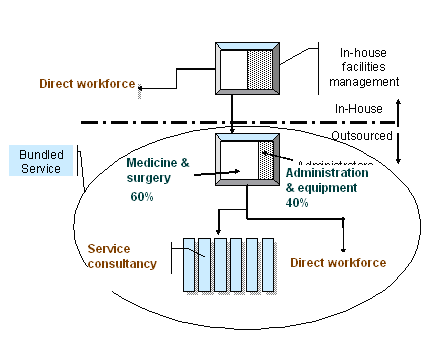
Typically, the outsourcing strategy states the sub- contracting of some managerial expertise while this service entity will also do it by following a combination structure. The mentioned figure has shown that similar condition where the hospital owns some of the in- house doctors as permanent employees. Outsourcing arrangement will take two forms; the direct HR category involves medical experts in special criteria like- gynecology, rheumatology, blood, or brain cancer etc. for which it will not have 24 hours servicing rather than maintain a particular time of the day or some other contingency contracts as well as emergency nursing based on contextual needs. On the other hand, administration will generally incorporate arrangement of various surgery equipments and trainers who will also be a part of direct HR but mostly perform the role of training the regular employees and staffs at necessary healthcare fields. Thus, the ratio of these two sections can estimated as 60: 20 who will jointly perform the core operational task. Formally, the entire process flow has mostly related with “bundling” which is a popular management term for explaining teamwork coordinated under a single provider for exposing integration in accomplishing a number of activities for an individual objective. For example, surgery, nursing, and equipment management are often bundled, therefore introducing a multi- tasking reporting procedure and removal of transformative or breaking up services for the client. One issue must remembered that the facilities manager should be well- responsible for many similar types of functional distribution while each would demand for individual contract and liaison.
- Benefits of intended outsourcing: According to Williams (1996), a desirable and logical strategic outsourcing may derive a number of benefits from both the clients and stakeholders’ perspective which could also be applicable for Benenden case:
- Reduction of overall costs of generating service for the hospital
- Assets will used to focus on improving the core business of serving pure medical care.
- Access of moving towards variable costs rather than fixed ones to be more predictable.
- The quality of delivered will be improved by combining twofold expertise.
- Better access to the intellectual property and knowledge,
- Access to legally bounded contacts and operational expertise,
- Accumulation of demandable talents that in turns resulting into broader managerial capacity.
- Upgraded change in servicing and innovation and others.
Thus, the decision of making an out- contract should judged carefully in light of some influential factors, like- cost, quality, risk and responsibility, diversity and project expertise, accountabilities, innovation, flexibility, investment, information and demand of clients etc.
Procurement circle of support services
Here, Benenden will need to make a prompt decision of outsourcing since it is an ongoing cycle. The projected stages can shown as:
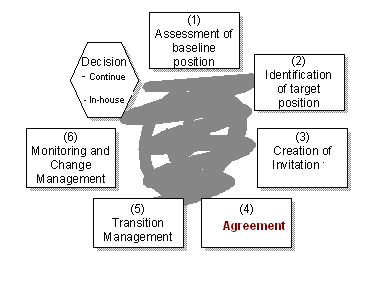
The 1st and 2nd steps will clarify three major issues, as:
- Delivering the demanded level of hospitalization,
- Identification of parties who would affect by that functionality,
- Matching the above issues with overall strategic view
The next step would concerned of inviting the selected personnel to be temporarily join at Benenden, which will actually go forward through some formalities like- letter of invitation, intention to application form, instructions for the applicants, application statement and specification regarding timing of contract, scope, policies, terms and conditions, standard performance and desired outcome, incentive program and application evaluation sectors. Although the fourth step is subject of various national laws that can apply mostly in public sectors, in case of a private hospital, it will focus of agreement of interested personnel for the selected posts. The transition step entails sincere management along with an enclosure of transition planning within 90 days. Finally, monitoring and change management will require some sub- steps as involvement of an alteration controller, accomplishment of periodic meeting, documentation scheduling, review of unsuccessful alteration program and get ready of any unexpected change (Source One Management Services 2008).
Relationship management
The core theme of relationship management for Benenden will emphasize upon clarifying the nature of organizational- sourcing relationship that can be summarised in openness, co- operation and trust, communication and informational distribution. Such operational modes are also effective for co-operated business objectives in association with outputs rather than improvement of a single unit. Thus, the partnership relationship will assist a “win- win” thematic application by which the performance of both parties would maximize.
Further, Benenden would use a FORT model to identify the pattern of outsourcing approach for achieving better competencies. FORT stands for Four Outsourcing Relationship Types will recognize two sorts of service provisions regarding ownership and strategic influence. So, to determine the projected level of effectiveness through these variables, few hypotheses can be developed, as:
- Total amount of time per day while the service providers are engaged in own functions with managerial control and decision- making power,
- Involvement of themselves in planning would thus place as substitutes of internal personnel.
The opposite proposition can also developed from outsourcing perspective, such as:
- Could the outsourcing strategy become a differential advantage for the hospital?
- Could that be effective for long- run patient satisfaction?
- Could it build up a strong partnership with in- house employees?
- Could it provide additional value to Benenden by orienting a new profit portfolio?
However, the following FORT model will show the possible condition of Benenden enlightened by those factors:
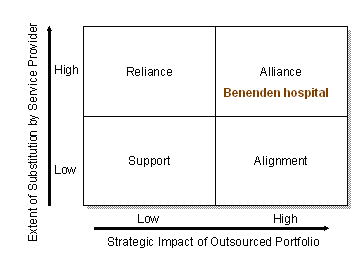
As we can see that among four types of strategic propositions, Benenden will expected to occupy the alliance form of relationship where the patron and service provider would perform a joint functionality like strategic co- operators. At this point, commitment of investing service skills, qualifications and technology is high from both criteria while such integration is showing a “locked- in” circumstances through evaluating performance. However, Benenden should maintain some integral policies to such benefits involving behavior- oriented performance evaluation, exposition of mutual trust, profit sharing methodology and emphasize on informal communication channel.
Total quality service
The concept of TQS has closely related with TQM, which would have one of the most important roles in building the sourcing strategy of Benenden in order to build customer loyalty, continuous trading, and referral, positive operational outcomes. It also provide flexibility and prompt response, effective expenditure and cyclic time and generating value for the hospital and suppliers. (ISO 9004 Section 0.1)
Therefore, Benenden will need to maintain eight principles to run proper quality through its organizational service, as:
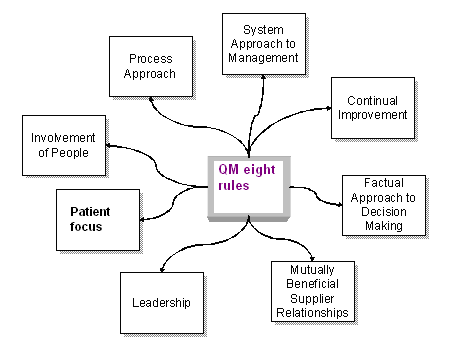
According to Sureshchandar (2001), the quality dimensions of a healthcare service as Benenden would be:
- Commitment of executive bodies
- HRM
- IT and IS
- Continuous improvement program
- Focus of patients
- Benchmarking
- Satisfactions of personnel
- Union involvement
- services capes
- Social responsibility
- Cultural focus
Among these services, capes and service culture tend to create confusion while the former indicates then visible infrastructures regarding hospital premises, clinical equipments and even the hosting behaviour. Such issues are highly influential in changing customer perception and thinking about the quality of the hospital. Thus, Benenden shout put a deep concern in carefully developing these elements so that the members would love to stay and have treatment there (Mehrabian 1974). Similarly, the later incorporates a professional composition of innovation, respect, group work, intimacy, expertise ad excellence (Berry 1999).
Consequently, to gauge TQS perfectly, Benenden will use a measurement tool named as SERVQUAL regarding its five major dimensions, as:
- Tangible assets relating facilities, instruments, linkages, and personnel,
- Reliability of delivering assured performance perfectly.
- Responsiveness of desiring to serve the patients promptly,
- Assurance regarding the integral skills of staffs to motivate trust,
- Empathy of deriving personal attention and care to each patient
Thus, the SERVQUAL would be a feasible tool of conducting yearly marketing research of the hospital while each of the mentioned dimensions can produce five options like a Likert scale ranging from “strongly disagree” to “strongly agree” at two extremes. The practical evaluation will make a distinction between “expectation” and “perception” (Malhotra 2007). Therefore, the scoring can view by an equation as:
SERVQUAL score = Score of perception – Score of expectation
Finally, according to Kang and James (2004), Benenden would adapt the SERVQUAL technique by following an “”European model” involving:
- Functional elements
- Services cape
- Technological competence
Such adaptation can perceive by Benenden, which can shown as:
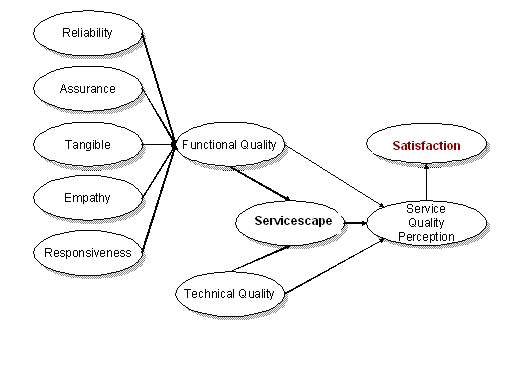
Service level agreement would be another managerial concern of Benenden. Although it had not originated from that field, the thematic learning from agreement should implemented here relating identification of individual patient’s needs, develop a structure of understanding, simplification of complicated cases and clash resolution etc.
Service risk management
For developing a reformatted risk management strategy, Benenden will need to establish strategies considering transformation of organizational risk to others, keeping away from it, removing the negative impact of it or agreeing upon minor or major impacts of risk. Thus, Benenden would face various types of risks considering development, financial, physical, partnership and regulatory aspects, which would generated from modified organizational facilities, ineffective monetary planning, and projection, more operational expenditures. It also utilise more of less functional areas as well as lack of other supportive facilities, proper maintenance of government health provisions and rules, lack of surgical equipments, manual usage rules etc. (Burke 2004).
However, there are many way, through which Benenden would like to assess the projected risks. Among them, a critically analytical approach would be ANP method. To apply this method, the hospital will need to conduct a sound marketing research strategy as idealized in previous section, which must involve interviewing a part of target customers for analyzing the present perceptual view of them in assessing risks. Thus, a questionnaire will be prepared to make such judgment, which will further followed by qualitative data analysis procedure for supporting the ANP framework as well as examining the effectiveness of the model in making managerial decision of the organization (Satty 2005 and Malhotra 2007). Regarding those aspects, the ANP risk analyzer can be portrait as:
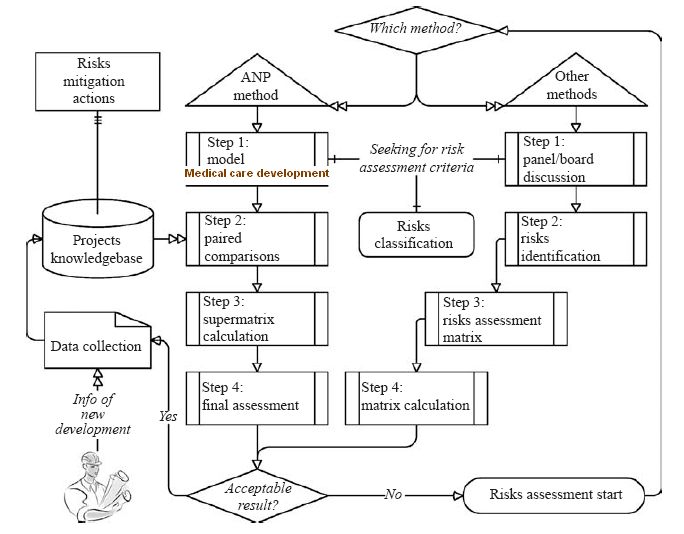
According to UK Health and Safety at Work Act, 1974, the central risk management committee of Benenden will be liable to serve a written statement of that policy to all the related parties with adequate clarity as well as placement of warning for not violating that rules in order to avoid penalties.
Therefore, a REACT model proposed by MacCrimon explains the possible risk management process that the hospital would adopt and Wehrung (1986) can placed as below:
- The first stage generally will started by an identification of associated risks.
- Risk evaluation will analyze the nature and possible influence of risks.
- Adjustment stage should “design- out” that risks.
- Choosing phase will involve responding to the risks.
- Tracking means risk evaluation.
- Finally, responding means designing a plan after realising the specific risk.
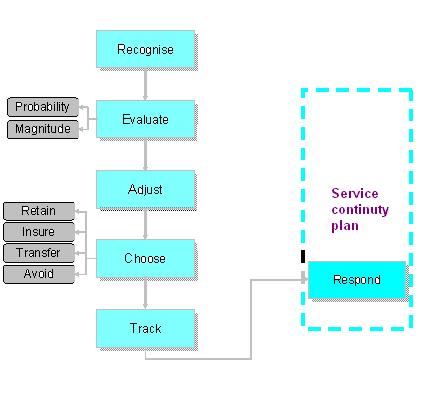
Each of those risks in light of Benenden hospital can be overviewed as:
- The hospital’s society would face risky situation at three levels incorporating substantial infrastructure, entity and inter- entity level. Similarly, various corporate sourcing risks would be realised in terms of manual knowledge as medicine intensity or understanding necessity, malicious activities as sabotage, illegal contract etc. Similarly, these risks would influence by hygiene and health risks. Methods like- brainstorming and scenario analysis would adopt to identify those risks while in brainstorming method; some cautions should be maintained relating quantity, criticism, scattered and modified ideas (Source One Management Services 2008).
- Benenden will consider two factorial variables for evaluating risk regarding probability of certainty, likelihood, moderation, and exceptionality while effect involves majority, minority, and moderation. On the other hand, scenario analysis would chosen for analyzing a particular situation, like- access problems for emergency services and difficulties in running ambulance at public strike (Jackson 2001).
- At the adjustment phase, the hospital management should develop specific ideas. For example, formulating the newer value gauges, monitoring and controlling them, focus on sourcing mottos before searching for a solution and eventually, stressing on outsourcing functions for assuming a realistic answer. Thus, the influence of value management especially driven from sourcing of the hospital accompanied by group working and favorable inner and outer response can be explained as:
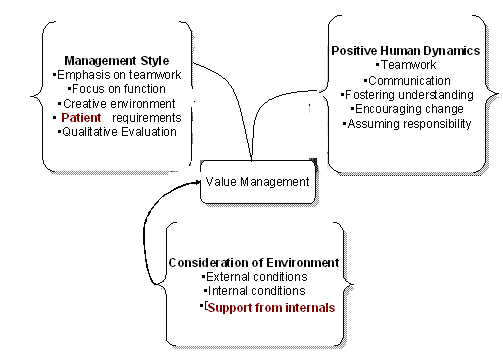
- According to Hollman (1991), there exist a number of formulas to cope with such risks among which the most feasible for Benenden would be using controlling mechanism through prevention, lowering, isolation, and combination of risk, making an insurance and non- insurance transfer of financial loss, and lastly, retaining it.
- According to Huffman (2002), the preference option will entail suitable diligence, prediction, diversification, and contingency planning while avoidance of such efforts would be resulted into negligence, implemental and financial looses from outsourcing decision taken by the top management committee.
- Tracking phase will normally be considered as “early warning” of making appropriate response through decision- making.
- According to Blades (2001), Benenden should put major attention in responding through understanding some disasters like- strikes, national political hazards or natural calamities cannot avoid arrangement of emergency workforces and immediate response. For example, placements of an internal surgeon at a contingent absence of an outsourced specialist when other approaches will involve delivering continue service though online or telephone, hospitalization recovery or turning back of the previous image etc.
At the finishing, the security plan should experienced by a formal business continuity planning where it will cover the several sub-plans, as:
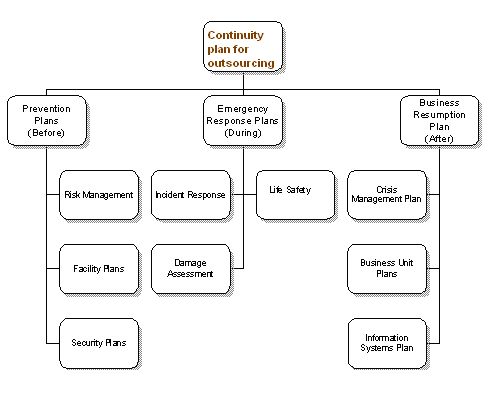
Therefore, according to Johnson (2001), Benenden will need to maintain that plan and must not be puzzled of operation through an exploration of following rules:
- Gaining of general managerial commitment;
- Development of a separate committee,
- Activate risk assessment models and analyzing the outcomes.
- Determination of improvement orientation,
- Making a good connection with sourcing agencies through written and oral commitment,
- Pre- examination of the plan,
- Regular examination and valuation of the presented approach,
As a result, the entire outsourcing strategy of Benenden would require to be introduced the overall issues ranging from designing framework to measuring and to lessening risk. In this cyclic process, information will play a significant role since all of those tasks would accomplished by an integrated manner. Therefore, the suggested level of integrative action will maintained through designing various sources like- manual, technological tools, software implementation, organizational system and critical recording etc., which would be able to increase reliability, trust, effectiveness and confidence of stakeholders at all levels towards the new sourcing strategy (Jackson 2001).
Service Level Agreement
In this part of the report, a practical illustration will applied based on different theories and conceptual models discussed previously. While quality management will be liable for improving quality, that agreement will take the responsibility of sustaining and assuring the desired level of service for the audience. As it has been assumed that Benenden is going to introduce an outsourcing strategy while it will outsource two types of resources regarding human and instrumental, HR part will be also be divided upon two groups considering clinical specialist and general nurses. Therefore, the Service Level Agreement will show the specific treatment sectors where Benenden will decide how many personnel will hired, approximately for what duration, at what cost, at what expected outcome and satisfaction level of the patients and more. Along with those conditional assessment, that agreement will also incorporate the hospital’s personal responsibility in delivering a combined service to the patients and other stakeholders. Making a written contact for practical accomplishment, the management will take the implementation plan for the next 5 years. Finally, the agreement will be prepared to give a roadmap for three groups regarding service providers as outsourced employees, service delivering organization as Benenden itself and community aid as admitted patients (Annual report 2007).
Therefore, the proposed outline of Benenden hospital’s SLA or Service Level Agreement will contain the following sections:
Delivery of specialized health care and treatment services
The hospital will be agreed upon generating formal healthcare services of cardiology, surgery, dermatology, medicine, ophthalmology, urology etc. along various pre- testing of urine, blood, ECG, X- ray etc. Additionally, it will provide special neuro rehabilitation service in a30- beds to young and adults suffering from complicated neurological diseases on inpatient, outpatient, and outreach basis. Ten staffs will hired who have trained from several UK smart assessment-training centres on neurology. Other commitments will be:
- 6- Bed facilities and two tracheotomies oriented staffs will improve the high dependency unit.
- Consultant- assorted Plasticity mini hospital will establish once a month within the hospital for pathology and follow up.
- Specialized committee will form to analyze whether the repatriating members will serve facilities that are more domestic.
- Serving temporary outreach consultancy will provide mostly through hired specialists while long- term rehabilitation treatments will pass through group consultancy.
Complex pain services will be an additional medical support of Benenden, which will mainly involve regional pain syndrome as well as chronic management of pain. Three consultants will hired having national and international fame in terms of clinical record and research and development experience. Benenden will also introduce residential and non- residential opportunities based on patient needs and level of complications. The core program will give an opportunity so that the patients can control their chronic pain by own within a 3 to 4 weeks pain management schedule. Other issues are:
- Offering packages for young and adult pain treatment.
- Development of inter- hospital complex pain treatment service especially governed by an external specialist once a week.
- Conduction of research oriented pain management teamwork.
- Mutual treatment arrangements with trained staffs along with academic bodies for accumulating funds specifically for pain treatment,
- Coordinating with ARMA and BANES for further sophistication,
For providing rheumatology care, Benenden will arrange 20- beds accommodation, day case, and outpatient based adult, young and children medical care facilities. Along with general treatment, special treatment will also give for Ankylosing Spondylitis, Complicated Regional pain Syndrome, Connective Tissue and Paget’s Diseases and Fibromyalgia etc. Other factors are:
- Inpatient waiting hour will be lessen.
- Effective orientation of MRSA program would obtain for each inpatient and day case patrons.
- Duration of two weeks diagnostic examinations,
CFS or Chronic Fatigue Services will be another specific medical service which will be delivered only for children, youth and older. Benenden will add special value in this sector by inviting nationally recognized medical experts. Here, treatment will offered through individual and group of patients with adequate prescriptions for taking care at home. Additionally, job- related research and development opportunities will give to the inner and outer specialists to develop a partnership environment in delivered task.
Clinical measurement will be another unit through which the hospital generates a bone densitometry function for registered and non- registered patients. By establishing such department, Benenden will be able to initiate a new dimension of image since such department is rare throughout the region and usually inadequate to meet huge needs of people along with thermography and micro-vascular examination laboratory. Such tools will be effective in diagnostic investigation of the patients casing chronic pains. A modified administrative system will initiated in this regard, which will greatly focus on reporting module by permitting moreover three weeks timing for proper accomplishment. Immediately from the beginning of next year, Benenden will be able to introduce a complete fall and Fraction Service of Liaison inside the hospital building. Finally, with a combined integration, Benenden will try to locate people suffering from osteoporosis as well as in continuous falling. After, initial identification, it will operate a special operation to cure them from that curse of diseases at least expenditure.
Research focus treatment plan
At the second phase of SLA program, Benenden will invest effort to develop the main premise related research laboratory where it would engage the internal medical team and invite external experts to run research on various ongoing and contingent topics. It would remedy of any epidemic diseases, innovation, or modification of any ultrasound scanning system, medicine to perform a painless operation etc.
Training and development: The regular administrative, managerial and health staff of the hospital will get related training under training and development section of the organization while the externals would get the same advantage on conditional basis.
Transparent business operation: One of the major region of service level plan is to ensure operational transparency while several factors will play greater contribution, like:
- The society tends to operate the present modification and future development programs with a surplus of £3.635 million of credit from member’s reserve in 2006 (Annual report 2007).
- The situation of membership statistics has shown a figure of 392993 during 2007, greatly been raised from 386155 in 2006 which is showing a positive trend in dealing with more diversified functionality and management. However, total nominees have slightly reduced during the same comparative years from 559377 to 560985 (Annual report 2007).
- The financial benefits are in upgrading position with a net increase in 11.22% in 2007 (Annual report 2007).
- The leading demand for domestic diagnostic service and seamless service has improved also from 12578 to 15617 in 2006 to 2007 (Annual report 2007).
- Benenden hospital is still in satisfactory position in terms of treatment referrals compared to other health care centers (Annual report 2007).
- At the end of the year 2007, the hospital has experienced practical investment performance of 1.9% output in return of Caps Pooled fund benchmarking accounted as 3.6% (Annual report 2007).
- Other transparency issues incorporate continuous membership liabilities, forthcoming service commitments, and tackling of uncertain events (Annual report 2007).
Conflict resolution functionality: In short, being enlighten with new sourcing strategic review, Benenden will try to response to the raised complaints within shortest possible time characterized by serious, prompt, and courteous notification. The projected solution would generally be taken place within 2 working days and nominally and 20 working days explicitly. Further dissatisfaction and conflicts would solved by a submission towards projected committee and at deeper level to the central board. Here, a written application format will maintain to get a quick solution from the board within 15 working days (Annual report 2007).
Cost, capital, and other financial issues: Here, assuming that the strategic change of the hospital through sourcing guideline will require incurring additional costs and estimating that capital investment would enhance by 20% while the costs would increase by 18%. In addition, such situation would generate an operating income of 30% higher than normal situation.
Thus, it can observe that the above SLA outline has shown a number of features, which are feasible enough to meet the formal objective of patronizing and serving patients at best, overall structural understanding of the business, minimizing the conflicting terms, and making valid proposition (Burke 2004).
Projected benefits
Involvement of the proposed new sourcing strategy regarding HR and equipment support would expect to deliver a number of financial and non- financial benefits to the hospital. The non- financial advantages will introduce improvement of present quality of hospitalization in terms of general medical care along with sophisticated treatment offerings for some special diseases, like- rheumatic fever, cancer and so one. Hiring external staffs for cleaning and security will be able to keep a favorable attitude in patients mind by adding a competitive advantage in those sectors than other medical centers. Since the hospital will serve some extra qualifications regarding its medical and non- medical services, a general and viral marketing effectiveness would amplified in additional revenues for the forthcoming financial years. Thus, positive cash flow would generate.
Conclusion
The ending part of the report can clarify the entire requirements of a projected sourcing strategy, which could implement in an existing strategic framework of a social organization as Benenden hospital. As the hospital is simply following an in- sourcing tactics through which it is running well but not at most sophistication and speed, the alternative one has been recommended to remove the existing problems by raising cost, investment and an ultimate enhancement of total revenue. After analyzing various aspects of outsourcing related management mechanisms, a process outline has shown which will incorporate several features of the hospital on personal projection and historic data with an optimistic projection to become successful for running through the sated sourcing.
Reference
Barret, P. & Baldry. (2002) Facilities Management. 2nd ed. Blackwell Publishing.
Benenden. Annual Report 2006 of Benenden. Web.
Benenden. Annual Report 2007 of Benenden. Web.
BRNHRD (2009) Bath Royal National Hospital for Rheumatic Diseases: NHS Foundation Trust. [Online] Web.
Burke, R. (2004) Project Management- Planning and control techniques. 4th ed. John Wiley and Sons (Asia) Pte. Ltd.
Chen, Z. & Khumpaisal, S. (2009) An analytic network process for risks assessment in commercial real estate development. Journal of Property Investment & Finance. Vol. 27 No. 3. Web.
Chen, Z. et al. (2008) Knowledge-Driven ANP Approach to Vendors Evaluation for Sustainable Construction. Journal of Construction Engineering and Management. Vol. 134, No. 12.
Churcher, D. (2008) A BSRIA Guide: Whole-Life Costing Analysis. Web.
Finch, E. (2006) Services Procurement and Provision. [Online] Web.
Griffin, R. W. 2006. Management. 8th ed. Boston New York: Houghton Mifflin Organisation.
Hitt, M. A., Ireland, R. D., & Hoskisson, R. E. (2001) Strategic Management. 4th ed. South-Western Thomson Learning.
Kishore, R., et al (2003) A Relationship Perspective in Outsourcing. Communications of the ACM. Vol. 46. No. 12. pp. 87-92.
Kotler, P., & Armstrong, G. (2006) Principles of Marketing. 11th ed. Prentice-Hall of India Private Limited.
Malhotra, N. K. (2009) Marketing Research- An Applied Orientation. 5th ed. Prentice-Hall of India Private Limited.
Rawlinson, T. & Howie, D. (2007) What Is Strategic Sourcing? Web.
Source One Management Services (2008) Where are the opportunities to reduce your cost and enhance operational effectiveness? Web.
Source One Management Services (2008) Source 1 provides a series of performance improvement services to continually achieve greater procurement savings while improving operational effectiveness. Web.
Source One Management Services (2008) The Basics of Procurement Service Providers. Web.
Stevenson, W. J. (2006) Operations Management. 9th ed. McGraw- Hill Company.
Turner, R. (2008) Gower Handbook of Project Management. 4th ed. Gower Publishing Company.
